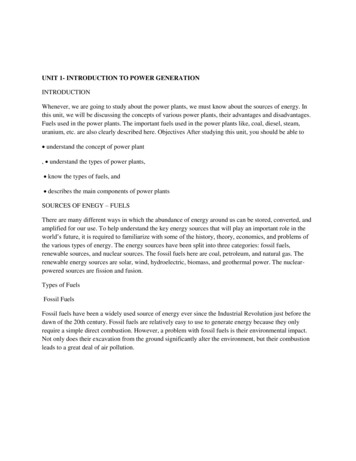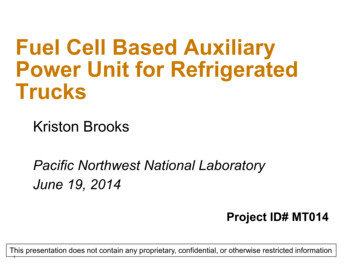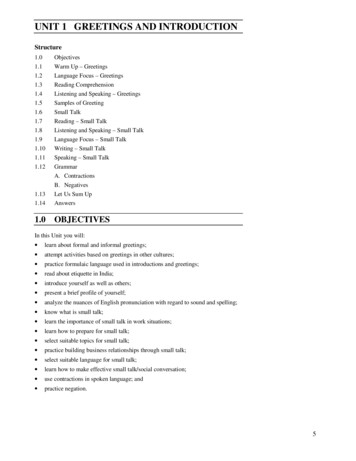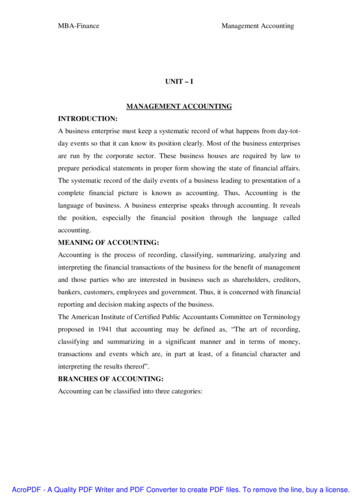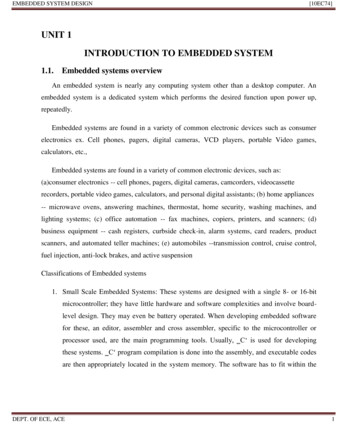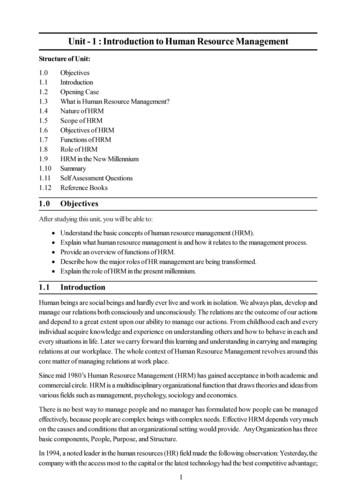
Transcription
UNIT 1 INTRODUCTION TO POWER PLANTSIntroduction toPower PlantsStructure1.1IntroductionObjectives1.2Sources of Energy – 7Wind1.8Geothermal1.9Ocean Energy1.10 Nuclear Energy1.11 Classification of Power Plants1.12 Summary1.13 Key Words1.14 Answers to SAQs1.1 INTRODUCTIONWhenever, we are going to study about the power plants, we must know about thesources of energy. In this unit, we will be discussing the concepts of various powerplants, their advantages and disadvantages. Fuels used in the power plants. Theimportant fuels used in the power plants like, coal, diesel, steam, uranium, etc. are alsoclearly described here.ObjectivesAfter studying this unit, you should be able to understand the concept of power plant, understand the types of power plants, know the types of fuels, and describes the main components of power plants.1.2 SOURCES OF ENEGY – FUELSThere are many different ways in which the abundance of energy around us can bestored, converted, and amplified for our use. To help understand the key energy sourcesthat will play an important role in the world’s future, it is required to familiarize withsome of the history, theory, economics, and problems of the various types of energy.The energy sources have been split into three categories: fossil fuels, renewable sources,and nuclear sources. The fossil fuels here are coal, petroleum, and natural gas. Therenewable energy sources are solar, wind, hydroelectric, biomass, and geothermal power.The nuclear-powered sources are fission and fusion.5
Power Plant Engineering1.2.1 Types of FuelsFossil FuelsFossil fuels have been a widely used source of energy ever since the IndustrialRevolution just before the dawn of the 20th century. Fossil fuels are relativelyeasy to use to generate energy because they only require a simple directcombustion. However, a problem with fossil fuels is their environmental impact.Not only does their excavation from the ground significantly alter theenvironment, but their combustion leads to a great deal of air pollution.TheoryThe theory behind fossil fuels is actually quite simple. Burning coal, natural gas,and petroleum releases energy stored in the fuel as heat. The energy contained bythe fuels is derived from the energy of the sun.The heat that is recovered upon combustion of the fuel can be used by us inseveral ways. Industrial processes that require extremely high temperatures mayburn a great deal of very pure coal known as “coke” and use the energy released todirectly heat a system. Some people make use of clean burning natural gas to heattheir homes. Combustion of fossil fuels can also be used to generate electricity;the fuel is burned to heat water, and the steam from the boiling water spinsturbines that power a generator, thereby manufacturing electricity:Figure 1.1 : Steam Power Generator1.3 COALAbout 300 million years ago, enormous ferns and other prehistoric plants were commonon the swamp-like earth. When those plants died and fell to the ground, they werecovered with water and they slowly decomposed. As decomposition took place in theabsence of oxygen, much of the hydrogen content of the matter was eroded away,leaving a material rich in carbon. The material was compressed over the years by sandand dirt, leaving the form of carbon known as coal.TypesThe nature of coal is such that the higher the carbon content, the more cleanly andbrilliantly the coal burns. Thus “peat”, which is the state of the decomposingplants before being compressed, is a weak, impure substance. The other states ofcoal from lowest carbon content to highest are lignite, bituminous coal, andanthracite coal. If the coal is heated and compressed even more, the result isgraphite, almost completely pure carbon.Nearly all the different forms of coal are used in some way or another. Forinstance, peat has been used for burning in furnaces, whereas bituminous coal isused extensively for the generation of electricity. “Coke”, a very pure form of coalwith high heat content is used primarily in the steel industry, where hightemperatures are required.6
Introduction toPower Plants1.4 POLLUTIONGlobal WarmingScientists believe that global warming is caused by the Greenhouse effect. Thegreenhouse effect describes the accumulation of carbon dioxide in our earth’satmosphere. A layer of gas forms that traps heat inside the atmosphere, therebyacting as the glass ceiling of a greenhouse. Because heat is trapped by the carbondioxide, it is believed that the earth is slowly warming. A potential danger ofglobal warming is the melting of the so-called polar ice caps at the north and southpoles. This occurrence would cause the ocean level to rise and perhaps flood manycoastal cities.The Advent of Fossil FuelsBefore humans were around on the earth, there was a relatively even recycling ofcarbon dioxide and oxygen. Plants require carbon dioxide to live, and they emitoxygen in return. Animals, on the other hand, need oxygen, but exhale carbondioxide. But as humans began to burn fossil fuels to create energy (especiallybeginning just before the 20th century during the Industrial Revolution), more andmore carbon dioxide was emitted into the air until the balance was slowlydestroyed.How Do Fossil Fuels and Biomass Pollute?All fossil fuels and biomasses consist of carbon and hydrogen atoms. When thesefuels are burned, or combusted, carbon atoms unite with oxygen in the air to formcarbon dioxide :Figure 1.2 : Fossil FuelsOther Polluting Byproducts of Fossil Fuel and Biomass BurningCarbon dioxide is not the only byproduct of direct combustion of fuel. Smallparticulates that can become imbedded in the human respiratory system are alsoemitted. Particulates can cause coughing and damage to the lungs. Further, theycan lead to cancer and lung disease.Carbon monoxide is produced when less oxygen is available in the immediatearea. Carbon monoxide is more directly harmful to humans because it is odorless,colorless, and reduces the body’s ability to transport oxygen. This leads to fatigue,nausea, and headaches.The Spectrum of PollutionMaterials on the low end of the energy scale such as wood and charcoal create themost pollution. Sources on the high end of the energy scale, such as natural gasburn very cleanly resulting in less air pollution.7
Power Plant Engineering1.5 HYDROELECTRICMan has utilised the power of water for years. Much of the growth of early colonialindustry can be attributed to hydropower. Because fuel such as coal and wood were notreadily available to inland cities, settlers were forced to turn to other alternatives. Fallingwater was ideal for powering sawmills and grist mills.As coal became a better-developed source of fuel, however, the importance ofhydropower decreased.TheoryHydroelectric systems make use of the energy in running water to createelectricity. In coal and natural gas systems, a fossil fuel is burned to heat water.The steam pressure from the boiling water turns propellers called turbines. Theseturbines spin coils of wire between magnets to produce electricity. Hydro poweredsystems also make use of turbines to generate electrical power; however, they doso by using the energy in moving water to spin the turbines.Water has kinetic energy when it flows from higher elevations to lower elevations.The energy spins turbines like as shown in Figure 1.3.In larger scale hydroelectric plants, large volumes of water are contained by damsnear the generator and turbines. The “forebay” is a storage area for water that mustbe deep enough that the penstock is completely submerged. The water is allowedto flow into the electricity-generating system through a passage called thepenstock. The controlled high-pressure water spins the turbines, allowing thegenerator to produce an electric current. The powerhouse contains and protects theequipment for generating electricity. The high-pressure water exits the systemthrough a draft tube. The fish ladder attempts to minimise the environmentalimpact of hydroelectric systems by providing a path for migrating fish to take.Figure 1.3 : Spinning Process of Turbine1.5.1 Types of Hydroelectric Power PlantsMicro-ScaleAs their name implies, micro-hydroelectric plants are the smallest type ofhydroelectric energy systems. They generate between one kilowatt and onemegawatt of power. The main application for these hydro systems is in small,isolated villages in developing countries. They are ideal for powering smallerservices such as the operation of processing machines.Small-ScaleSmall hydropower systems can supply up to 20 megawatts of energy. Thesesystems are relatively inexpensive and reliable. They have the potential to provideelectricity to rural areas in developing countries throughout the world. Smallsystems are especially important to countries that may not be able to afford thecosts of importing fossil fuels such as petroleum from other countries.8
Introduction toPower PlantsRun-of-the-RiverIn some areas of the world, the flow rate and elevation drops of the water areconsistent enough that hydroelectric plants can be built directly in the river. Thewater passes through the plant without greatly changing the flow rate of the river.In many instances a dam is not required, and therefore the hydroelectric plantcauses minimal environmental impact on its surroundings. However, one problemwith run-of-the-river plants is the obstruction of fish and other aquatic animals.This and other problems are discussed in the next section.Problems with Hydroelectric PowerAlthough hydroelectric power is admittedly one of the cleanest and mostenvironmentally-friendly sources of energy, it too has the capability to alter ordamage its surroundings. Among the main problems that have been demonstratedby hydroelectric power is significant change in water quality. Because of thenature of hydroelectric systems, the water often takes on a higher temperature,loses oxygen content, experiences siltation, and gains in phosphorus and nitrogencontent.Another major problem is the obstruction of the river for aquatic life. Salmon,which migrate upstream to spawn every year, are especially impacted byhydroelectric dams. Fortunately, this problem has been dealt with by theproduction of fish ladders. These structures provide a pathway for fish to navigatepast the hydroelectric dam construction.Advantages and DisadvantagesAdvantages Inexhaustible fuel source Minimal environmental impact Viable source--relatively useful levels of energy production Can be used throughout the worldDisadvantages Smaller models depend on availability of fast flowing streams orrivers. Run-of-the-River plants can impact the mobility of fish and otherriver life.Note : Building a fish ladder can lessen this negative aspect of hydroelectricpower.1.6 SOLARThe name solar power is actually a little misleading. In fact, most of the energy known toman is derived in some way from the sun. When we burn wood or other fuels, it releasesthe stored energy of the sun. In fact, there would be no life on earth without the sun,which provides energy needed for the growth of plants, and indirectly, the existence ofall animal life. The solar energy scientists are interested in energy obtained through theuse of solar panels. Although the field of research dealing with this type of solar poweris relatively new, one should bear in mind that man has known about the energy of thesun for thousands of years.TheoryThe energy of the sun can be used in many ways. When plants grow, they store theenergy of the sun. Then, when we burn those plants, the energy is released in theform of heat. This is an example of indirect use of solar energy.9
Power Plant EngineeringThe form we are interested in is directly converting the sun’s rays into a usableenergy source : electricity. This is accomplished through the use of “solarcollectors”, or, as they are more commonly known as, “solar panels”.There are two ways in which solar power can be converted to energy. The first,known as “solar thermal applications”, involve using the energy of the sun todirectly heat air or a liquid. The second, known as “photoelectric applications”,involve the use of photovoltaic cells to convert solar energy directly to electricity.There are two types of solar thermal collectors. The first, known as flat platecollectors, contain absorber plates that use solar radiation to heat a carrier fluid,either a liquid like oil or water, or air. Because these collectors can heat carrierfluids to around 80oC, they are suited for residential applications. The second typeof solar collectors is known as concentrating collectors. These panels are intendedfor larger-scale applications such as air conditioning, where more heating potentialis required. The rays of the sun from a relatively wide area are focused into asmall area by means of reflective mirrors, and thus the heat energy is concentrated.This method has the potential to heat liquids to a much higher temperature thanflat plate collectors can alone. The heat from the concentrating collectors can beused to boil water. The steam can then be used to power turbines attached togenerators and produce electricity, as in wind and hydroelectric power systems.Photovoltaic cells depend on semiconductors such as silicon to directly convertsolar energy to electricity. Because these types of cells are low-maintenance, theyare best suited for remote applications.Solar power has an exciting future ahead of it. Because solar power utilizes thesun's light, a ubiquitous resource (a resource that is everywhere), solar panels canbe attached to moving objects, such as automobiles, and can even be used topower those objects. Solar powered cars are being experimented with more andmore frequently now.Problems with Solar PowerSolar power is actually one of the cleanest methods of energy production known.Because solar panels simply convert the energy of the sun into energy thatmankind can use, there are no harmful byp
Power Plant Engineering 1.5 HYDROELECTRIC Man has utilised the power of water for years. Much of the growth of early colonial industry can be attributed to hydropower. Because fuel such as coal and wood were not readily available to inland cities, settlers were forced to turn to other alternatives. Falling water was ideal for powering sawmills and grist mills. As coal became a better-developed .File Size: 344KBPage Count: 15


